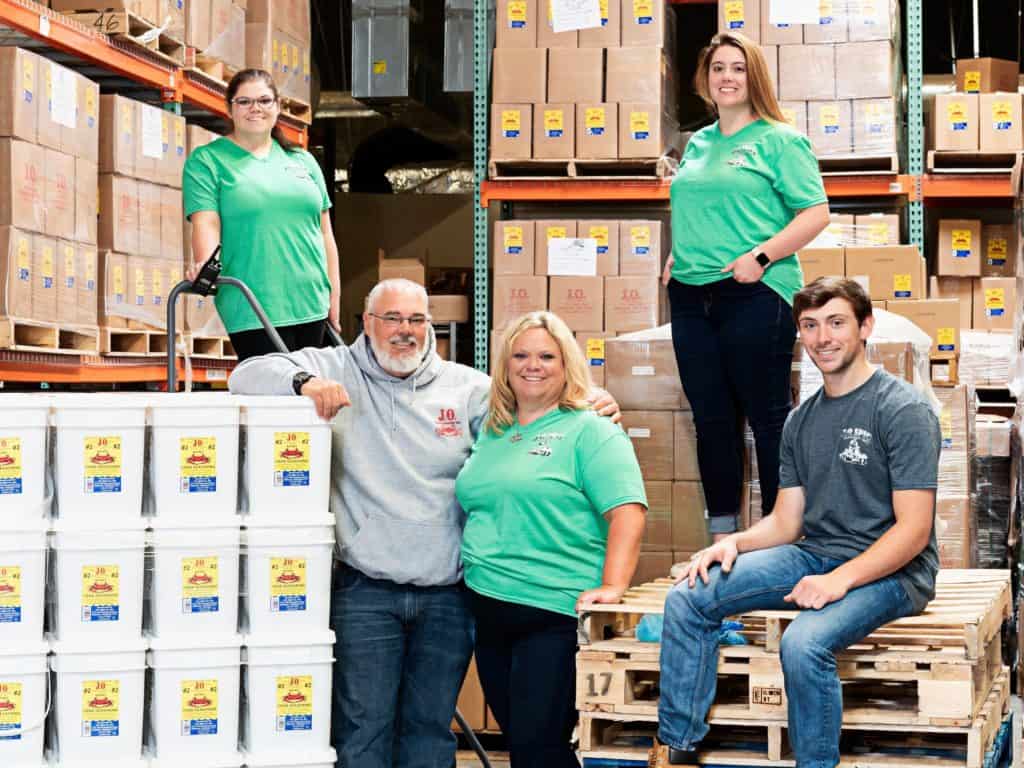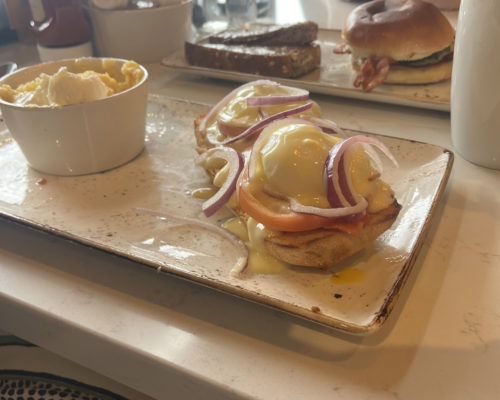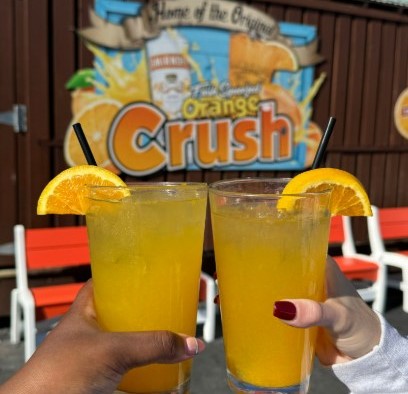That spice that gives crabhouses their flavor? It’s a family secret.
When he first started working in the family spice factory, Don Ports was too young to remember what he actually did. “Probably more like getting in the way than actually working,” he says. But his memories from a few years later are clear.
“I remember filling those yellow paper cans,” the President of J.O. Spice says. “You’d put the cans in a box, a big fill box, then pour the spice that way when you filled it. Then you’d take the box outside and shake the spice off it.”
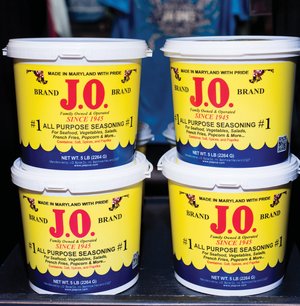
These were three-by-four foot crates with 48 one-pound cans of spice in them. Ports estimates they weighed 60 or 70 pounds. They were all filled, capped, and moved by hand, and that was fine back then: “It was extremely small. If we did like 10 cases a day. That was a lot.”
This was the early 1980s, when Ports was 13 or 14. J.O. Spice is orders of magnitude larger today, thanks in large part to Ports, the founder’s grandson. Ports says J.O. Spice ships more than 3.5 million pounds of spice blends every year, mainly to thousands of crab houses up and down the east coast.
That’s about five tons a day of a product that is typically dispensed by the teaspoon—but it’s still a small family-run operation.
“No one has job titles,” says Brittany Osborne, Don’s daughter, showing a reporter around the warehouse. “We’re like a family.”
J.O. Spice is the Chesapeake’s other signature steamed crab flavor—the one you maybe haven’t heard of. When you’re crab-feasting with out-of-state guests, you’re probably thinking of Old Bay, which was founded in 1939 and family-operated until they sold out to McCormick around 1990. J.O. is not Old Bay, but its origin story is similar. And if you’re cracking crabs at a Chesapeake-area crab house, there’s a pretty good chance that’s J.O. Spice covering them.
In 1945, James Ozzle Strigle and his wife, Dorothy, founded J.O. Spice on Pratt Street in Baltimore, having moved from Tangier Island. Strigle was a waterman who developed a seafood spice mix when he was working the Bay. “He saw the demand,” Ports says. “Obviously he had experience in the meat industry. So it was J.O. Spice and Cure Company. That’s still the federal, legal name when we file taxes.”
Most meat (and a lot of fish) was salt cured back in the days before freezers became ubiquitous.
The company moved to Gable Avenue, then Hollins Ferry Road in the late 1970s or early ‘80s, when Ports was a teenager. The shop moved again while Ports was in the service, to Hammonds Ferry Road. “We stayed there until ‘91. When my daughter was born,” he says. Then CSX, which owned the property, expanded, and J.O. Spice moved again to the complex at Old Georgetown Road in Halethorpe.
“That was when food safety and the health department came around,” Ports says.
Ports had recently been discharged from the Marines, and he had his eyes set on a career as a state trooper. But his grandmother, who was still running the company 45 years after co-founding it, brought him in to augment the family business. He says he discovered some of the workers were “taking advantage.” Long lunches, that sort of thing.
Aiming to get the operation more ship-shape, “I started writing things down on paper,” he says.
A few personnel changes followed. New food safety regulations came as well. The company was mixing spices in the same room it packed boxes. “We had dust,” he says. “A lot of dust.”
The regulators told them to enclose the mixing room. So they did, and it was a lot of work. J.O. Spice was already big enough that moving required cranes and professional riggers, he says.
At the same time came what Ports calls “the crab explosion.”
As the supply of Chesapeake Bay blue crabs waxed and then, mostly, waned, “they started trucking crabs up from Louisiana,” he says. “Back in the day it was just in season.” Suddenly, crab shacks were staying in business year-round and needed product—both piscine and condiment—to feed the region’s (and tourists’) growing appetite. “I was working 20 hours a day for three straight weeks that summer,” Ports says, over the phone from Naples, Florida, where he goes from January to the start of May each year these days.
The J.O. Spice warehouse is arranged like a gargantuan grocery store, with 30-foot-wide aisles stacked 30 feet high with salt and raw spices in industrial sacks and hot tub-sized plastic bins made for forklifts. There are pallets of cardboard boxes ready to be assembled, brown craft paper to spread on tables ($55 a roll, Osborne says, marveling), and cartons of customized crab mallets. It’s quiet here in late March, but there is a dozen or more people working, stocking up for the coming rush. “When you
come through in the summer this will be gone,” she says, gesturing to the one-ton bags of spice racked above us on huge steel shelves.
The plant nearly doubled in size a few years ago when it broke through the wall at its present location, taking over a closet wholesaler’s 14,000 square feet. Shaun Dunbar, the warehouse manager, supervises a crew of three as they package a spice run. In a corner of the room a boom box blasts pop music under a no-smoking sign. A forklift beeps through carrying a heavy sack as the men stride around it.
Osborne shows off the tape machine for sealing the boxes and the conveyor with rollers to move them along, assembly-line style. The spice boxes are lined with blue bags, chosen to contrast with the product on the occasional misfill. Clear bags could be lost; blue is visible.
The blending machines’ huge hoppers line the walls of the adjacent sealed room, their maws, able to swallow a ton of salt, garlic, paprika, mustard, thyme and what-have-you, 20 feet or more above the smooth and hospital-clean concrete floor. There is a half-size mixer for smaller batches and, on the floor, two other mixers: one for even smaller runs and one for test batches. The small mixer is about the size of a six-year-old; the smallest one is maybe triple the size of a home KitchenAid stand mixer.
“Everything is cleaned after every run,” Osborne says, pointing out various specialized cleaning dispensers and built in hoses jutting from the walls here and there throughout the property.
For distribution, the spice blends go into plastic tubs with one-ton “supersack” liners. The crew puts a ton of a new spice mix at the top of one of the cranes, funneling it into another hopper with machinery that flows it into 50-pound boxes below, where workers set them on the rollers to convey through the metal detector, which beeps fiercely when a test stick is put through, but is otherwise silent.
Besides J.O.’s own #1 and #2 blends, custom blends are its specialty. If you own a crab house and want to do your own seasoning, you work it out, give J.O. the recipe, they make a batch and you test and approve it, then they supply your spice to your place.
“People take ours and want it a little hotter, or more mustard in it,” Ports says. “They have a custom blend that I won’t sell to anyone else.”
The company makes about 400 different custom blends. The recipes are printed but each production worker gets only one element so that no one in the warehouse knows the whole formula, Osborne says.
This is necessary in part because crab houses do try to nick one another’s formulas. “Two or three times a summer,” says Ports, “someone from Crab House B calls and says he’s Crab House A and send me my stuff to this new address.”
Having been in the business since he was a child, Ports can smell them coming, and he does not fall for it. But there are those rare occasions when the wrong blend goes out to the wrong restaurant. “You got 20 different blends on the delivery truck and half are custom blends, sometimes the driver makes a mistake,” he acknowledges. “Harry calls and says he got two boxes of John’s spices.”
Then it’s down to how well John and Harry get along. Sometimes it’s fine: Harry drives down to John’s place and they have a laugh. Sometimes it’s not, and Ports himself hops in a truck.
“We try to maintain old fashioned customer service,” he says.

J.O. makes more than spice blends. There are batter mixes too, and a product called “Dumpster Cure” to deodorize trash receptacles, and then there’s a whole store filled with tchotchkes—mugs, glasses, caps, scarves, signs, and t-shirts.
“We try to get as many Made-In-America products as we can,” Osborne says, pointing to some barn wood and metal signs leaning in a corner of her office. The man who makes them works out of a barn in upstate New York, she says, laser or water-jetting the metal letters and affixing them to old wood for that rustic look.
Then there are the mallets.
Crab mallets, custom laser-etched in-house with various corporate logos and personalized messages, have become a substantial element of J.O.’s business, available at crab houses, curio and gift shops across the land and at the occasional, exceptionally tasteful, wedding reception.
In a small room just off the 600-square-foot retail store, the mallets are racked in a jig in one of the company’s laser etching machines, engraving them for the Havre de Grace Decoy Museum. Looking like freezer cases in a corner store are five new, quiet, smooth machines vented to the outside wall, their styluses silently hovering over the work, which glows with a faint spark where the laser is etching it.
“When the crabs are slow. The seafood places and stores were looking for other stuff to keep people coming in. So, if you’re in Ocean City from out of state you can get something to remember the trip by,” Osborne says.
The mallets were her mother, Ginger’s, idea and reportedly she had to sell it hard to the rest of the company’s board.
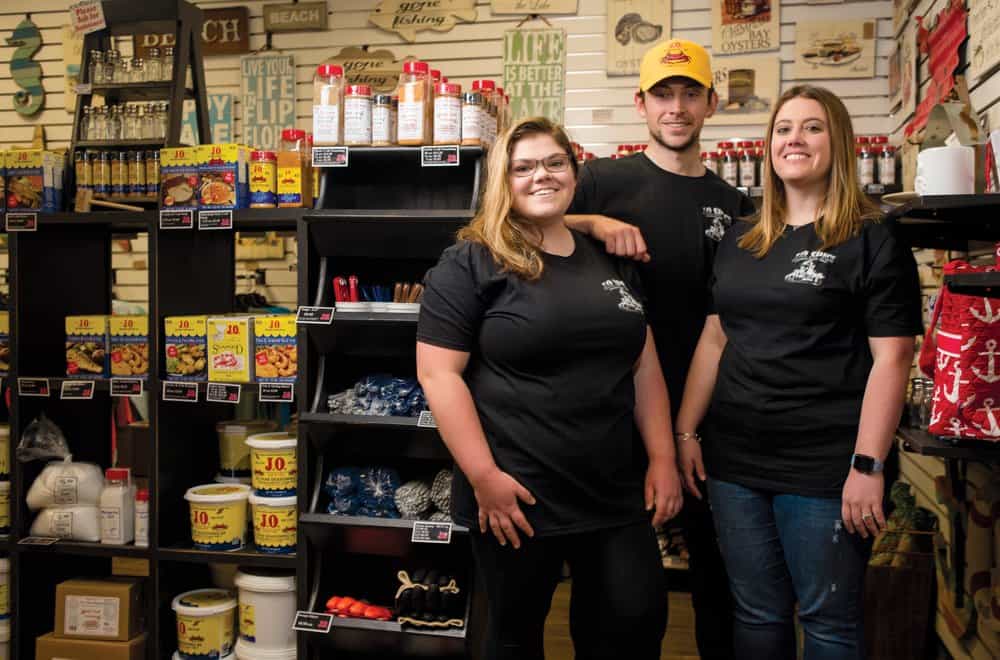
Osborne pauses in the old entranceway to the complex, a 10- by 10-foot vestibule that used to be the company’s entire retail operation. There’s a break room with a fridge and coffee machine, and beyond that, a larger area where more workers are packaging smaller shipments: more laser etching; and men and women running those roller conveyors and taping boxes. Orders to the online store show up on a screen out here. “We usually ship same day,” she says proudly.
But, during the busy season she doesn’t always get to it every day. Sometimes, she allows, it’s two days.
In the warehouse the pallets of mallets are stacked 12 feet high. “These are for Conrad’s and Phillips,” Osborne says. J.O. Spice sold more than half a million of these last year.
This kind of bulk wholesaling is a different business model than what McCormick does with Old Bay. Its pallets of 50-pound boxes on the loading dock instead of four-ounce cans on the grocer’s shelf, and it keeps J.O. under the public’s radar. Ports is fine with that.
“We never, ever knock them,” he says of the giant spice conglomerate headquartered 20 miles away. “We used to buy raw materials from them.”
Old Bay and J.O.#2 are “two different flavor profiles,” Ports says—although the differences are subtle to most palates (Old Bay gives a hint of clove, J.O.’s flaked salt adheres better to the crab). Conrad’s is a good example of a J.O. Spice customer, Ports says. “A good story you could do, something to think about in the future, you could do a story of what’s involved in running a top-notch crab house. A lot of people don’t understand. They just go and buy ‘em and eat ‘em. They think they’re eating Old Bay and they’re not.”

